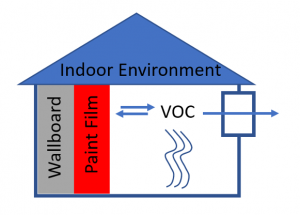By Lucas Algrim, a recent PhD student in Paul Ziemann’s research group at University of Colorado Boulder.
A range of volatile organic compounds (VOCs) can be found in the indoor environment. Many VOCs will be ventilated out of the building by the air handling system, but they can also sorb to indoor surfaces, in other words, they can accumulate on or inside these surfaces. Indoor air scientists have long been aware that VOCs can sorb to surfaces, and that the magnitude of sorption can depend greatly on the surface in question. In this study, we utilized various experimental procedures and models to better understand how VOCs interact with one of the most abundant indoor surfaces, latex paint films.
The extent to which a VOC will sorb to a paint film over time depends on a few important things: how volatile the VOC actually is, how much it “likes” the paint film from a chemical standpoint, and how quickly the VOC can move, or diffuse, into the paint film. The volatility, which is a measure of how much the organic compound likes to be in the gas phase, can be estimated from various methods established in the literature. In this work, we measure how quickly VOCs diffuse in a paint film, which correlated well with VOC volatility. This correlation allows us to predict the ways that other VOCs might diffuse in latex paint films indoors. We also show the degree to which a VOC will “like” a paint film can be approximated from the actual mass of paint present in an indoor environment. This is useful from a modeling perspective, because paint mass in a modeled environment can be determined by the surface area of the painted walls and thickness of the paint film.
Finally, we show the utility of our results by incorporating them into a simple house model. The model, which used typical dimensions of a residential house, was able to predict the extent to which a VOC could fully permeate the paint film and reach the wallboard behind it. Our model predicted that for a VOC with a volatility similar to octane, ~50% of the VOC that sorbed to the paint surface of a typical thickness (150 μm) would fully permeate the paint film. VOCs would permeate the paint to a greater extent if the paint film was thinner, or if the VOC volatility was lower. Overall, these results demonstrate that many VOCs indoors will sorb to and accumulate in paint films, and large amounts of VOCs even reach the wallboard behind the paint.
Read more about this work in this paper:
Algrim, L. B., Pagonis, D., de Gouw, J. A., Jimenez, J. L., and Ziemann P. J. Measurements and modeling of absorptive partitioning of volatile organic compounds to painted surfaces. Indoor Air, 2020. 00; 1-12 doi.org/10.1111/ina.12654
